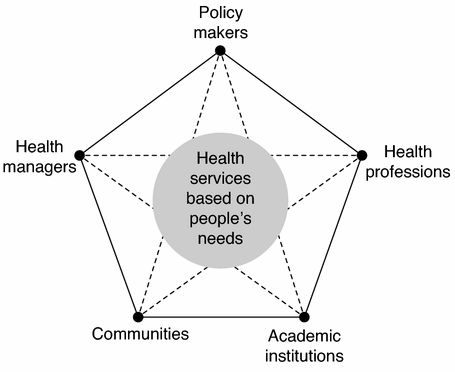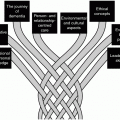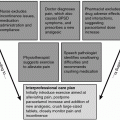- Interprofessional education (IPE)
Interprofessional education occurs when two or more professions learn with, from and about each other to improve collaboration and the quality of care (http://www.caipe.org.uk/about-us/defining-ipe/). When students from two or more professions learn about, from and with each other to enable effective collaboration and improve health outcomes (WHO, 2010).
This chapter will look at the origins of IPE internationally, and the health care environment in which dementia care is to be provided, and ask: What is it? How was it developed? Why do we need it? What does it look like?
Drivers for changing the way health care is provided
In 2012, Health Workforce Australia published documentation looking to the future of what would be required for the health workforce in 2025. It articulated the need to develop a health workforce that would work towards new models of health care and, therefore, the need to develop new models of education and training. However, this concept is not new. Indeed Flexner (1910) advocated the need to transform medical education, shifting from an idiosyncratic apprenticeship model to a more rigorous systematic biomedical and educational approach.
Whilst Flexner is recognised as being key, at that time, to the transformation within the medical and health care curriculum, it was a report published by the World Health Organization (WHO) in 1978 that emphasised the need to ensure that health professionals would work together and gain appropriate competencies (see pp. 11–12, Chapter 1, for the quote from this report). The global need to constantly renew and review health care curricula can be traced to this time. However, developing a curriculum to facilitate what we now term as ‘interprofessional education’ has been slow in its inception and development.
Tope (1996) provided a review of IPE internationally and indicated that ‘despite an intensive search, very little literature was found to describe interdisciplinary (interprofessional) activities in either Australia or New Zealand.’
Yet IPE has been a key agenda within government policies internationally for the past 30 years. Many recent reviews of health care systems in the UK (The King’s Fund, 2011), Australia (Garling, 2008) and internationally (West, Patera & Carsten, 2009) point to the need for new interprofessional models of health service delivery into the future. Equally these reports emphasise the impact of demographic trends in which there is an increasing ageing population and a decrease in the number of health professionals available to work in aged care environments.
Dementia is recognised by WHO (2010) as an international public health priority and by Australia as a national health priority. As a result of the ageing population, the prevalence of dementia is expected to rise exponentially in coming years, with growing economic and emotional costs to society. While a cure for dementia is not yet available, well-being and quality of life can be optimised with adequate care and support services.
A push for community working, and supporting the health and care needs of people within the community rather than within hospital or residential care environments, has highlighted the need for collaboration across sectors, particularly between health and social care, but also housing, law enforcement, etc. The UK policy document Our Health, Our Care, Our Say in 2006 emphasised the need for collaboration across these sectors. Similar issues have been highlighted in Australia (Garling, 2008).
What is interprofessional education and how was it developed?
IPE is an overarching term used to describe the theoretical and practical components of an individual’s experience. It is defined by the Centre for the Advancement of Interprofessional Education (CAIPE) (2002) as ‘those occasions when members (or students) of two or more professions learn with, from and about one another, to improve the collaboration and the quality of care’. The main emphasis, therefore, is the quality of care that an individual or a community receives.
The need for new models of health care for greater collaboration and communication between professionals is most apparent when the breakdown of communication leads to a detrimental effect on a person’s health and well-being and, in some cases, premature death.
Collaboration, in the form of communication, is necessary between professionals to ensure quality of care. For IPE to take place, therefore, communication, exchange and collaboration need to take place with, from and about each of the professions in order for it to be called ‘interprofessional education’.
Barr (2007) outlines the UK development in IPE between 1966 and 1996, stating that the origins of IPE were often termed ‘shared learning’, and that these developments were examined earlier by Forman and Nyatanga (1999). Both of these articles outline the need for professions to concentrate on the quality of care of the individual patient, client or community, rather than on the professional background or professional body with which the practitioner may associate. Forman and Nyatanga (1999, 2001) give some insight into why professionals collaborating with each other may find it difficult, by looking at the psychological theory called ‘ethnocentricity’. Barr (2007) has outlined the wide variety of work that has taken place since 1966 to improve collaboration between professionals and to break down the barriers, with a view to ensuring the quality of the care of the individual is enhanced, both now and in the future.
Whilst in Australia concerns about collaboration and interprofessional working were not historically highlighted in policy documents (Tope, 1996), some research was undertaken by Owens, Carrier and Horder (1995). It is clear that from mid-2000 onwards both Health Workforce Australia and the Office of Learning and Teaching have been particularly interested in this area and have funded a number of research projects. The first of these was documented by Learning and Teaching for Interprofessional Practice (2009).
Why do we need interprofessional education?
Learning to collaborate
International policies and changes in health care delivery call again and again for professionals to learn together and to work together. In its report Learning Together to Work Together for Health (1988), WHO called for all regions internationally to consider the benefits of professionals learning together and working together. In 1998, the European region produced a document called Health for All in the 21st Century, which incorporated a policy framework colloquially known as ‘Health 21’. All UK policies since this time can be linked back to this document and, therefore, to the original WHO policy. Tope (1996) wrote that Health 21:
is littered with references to the need for collaborative frameworks; integrated approach; co-operation; common approaches; pooling of resources; common values; and furthermore it signals the need to strengthen, adapt and reconfigure models of health service delivery based on evidence of best practice and sustainable strategies.
- Integrated approach
Leutz (1999) defines the integrated approach to care as: ‘The search to connect the healthcare system (acute, primary medical and skilled) with other human service systems (e.g. long-term care, education and vocational and housing services) to improve outcomes (clinical, satisfaction and efficiency)’.
Meads (2006) found that developed countries, such as Australia, Malaysia, and those in Europe and North America, had similar policies about primary care and, indeed, IPE. Developing countries, such as Algeria, Cameroon, the Dominican Republic, Fiji, the Philippines, Thailand, Sudan, Lebanon, Columbia and South Africa, did not use the terms ‘primary care’ or ‘interprofessional education’ but did look at collaborative models and ways of working with a focus on the individual and a much wider context than just health. Meads indicated that India had an excellent example of both primary care and IPE, and that, perhaps, developed countries could still learn from those considered to be developing.
In a report, Health Canada indicated that:
changing the way we educate health professionals is key to achieving system change and to ensuring that health providers have the necessary knowledge and training to work effectively in interprofessional teams within the evolving health care system.
(Hoffman et al., 2008)
In Australia, the Department of Health Western Australia (2006) indicated that universities should develop closer links between medical schools, schools of nursing education and allied health schools, with a view to providing more joint education between health profession students and collectively consider how health professionals should be educated. The report encourages a focus on:
- the patient, individual or community;
- consideration of demographics, human factors, communication and collaboration between members of the health care team;
- quality improvement;
- ethics;
- individual and group care dynamics;
- professional responsibility.
As indicated in Chapter 1, there are many groups internationally that have formed to share good practice in IPE. These include:
- The Network: Towards Unity for Health (The Network: TUFH), which is closely associated with WHO, and has a task force of IPE;
- Canadian Interprofessional Health Collaborative (CIHC);
- Centre for the Advancement of Interprofessional Education (CAIPE), which is UK-based;
- Australasian Interprofessional Practice and Education Network (AIPPEN);
- International Association for Interprofessional Education and Collaborative Practice (InterEd);
- European Interprofessional Practice and Education Network (EIPEN);
- Nordic Interprofessional Network (NIPNET);
- Japan Association for Interprofessional Education (JAIPE);
- American Interprofessional Health Collaborative (AIHC).
In 2014, each of these groups reinforced their agreement to collaborate with each other so that the good practice emerging within each organisation and the networking within each particular group can also be shared internationally. It is interesting to note that, from the early part of this century, The Network: TUFH (a non-governmental organisation in an official relationship with WHO) has worked on the model, concentrating on the delivery of health services based on people’s needs (at its centre) (see Figure 3.1) in collaboration with policy makers, health professions, academic institutions, communities and health managers.

Figure 3.1 The Towards Unity for Health Model (Boelen, 2006) Reproduced with permission from The Network: Towards Unity for Health
Stay updated, free articles. Join our Telegram channel

Full access? Get Clinical Tree






